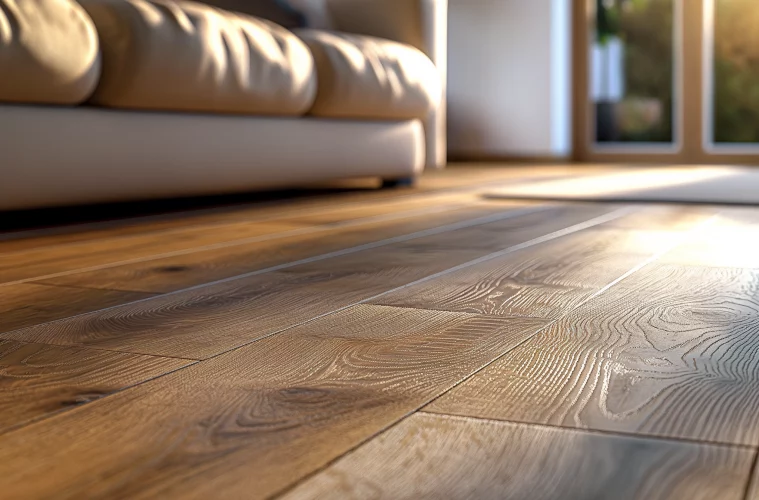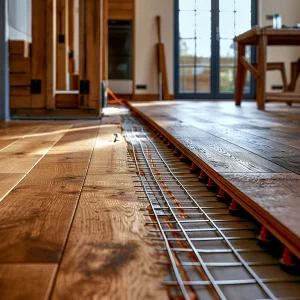System Compatibility and Wood Types
When considering heating solutions for your home in London, evaluating the compatibility of underfloor heating systems with different wooden floors is essential. Engineered wood is generally preferred over solid hardwood when paired with underfloor heating. This preference is due to the engineered wood’s thermal stability and lesser tendency to warp under varying temperatures, a common issue with solid hardwood. The types of wood flooring available include options such as engineered wood and solid hardwood, each with its distinct characteristics and suitability regarding underfloor heating.
Wood is an insulating material by nature. It does not conduct heat as efficiently as other materials, like stone or tile. Therefore, when using wood flooring with underfloor heating systems, it is crucial to consider this natural property, as it affects the system’s overall efficiency and heat distribution capabilities.
Underfloor Heating Systems: Electric and Hydronic
There are two primary types of underfloor heating systems: electric and hydronic. Electric systems utilise heating mats or cables installed beneath the flooring, making them particularly suitable for projects where quick installation is a priority. On the other hand, hydronic systems circulate heated water through pipes installed beneath the flooring. While hydronic systems are generally more efficient and maintain lower operating temperatures—typically between 35°C and 45°C—they are better suited for larger areas that are consistently used, benefiting from the system’s efficiency over time.
Electric systems are often recommended for denser and thinner wood types due to their quick response time and easier installation process. However, hydronic systems may be more appropriate for those prioritising long-term efficiency and installing heating in extensive areas. These systems require careful consideration of insulation to prevent heat loss and ensure that the warmth generated is effectively utilised.
Heat Conductivity
For optimal heat transfer, the thickness of the wood flooring should not exceed 18mm. Thicker boards can hinder the efficient transfer of heat from the underfloor system to the room. Engineered wood flooring tends to perform better in these setups due to its construction, promoting good thermal conductivity and facilitating a more uniform heat distribution.
Installation of these systems requires careful attention to several factors. After installation, the wood must be acclimated to the indoor environment to prevent excessive expansion or contraction. Additionally, the subfloor must meet specific requirements to support the heating system effectively, including proper insulation and moisture control. Ensuring even heat distribution is crucial to avoid temperature spikes, damaging the wood and affecting its longevity and appearance.
Temperature Management
Maintaining the correct temperature is crucial to prevent damage to the wood flooring. The maximum surface temperature for wooden floors with underfloor heating is around 27°C. To achieve precise temperature regulation, it is advisable to use thermostats equipped with floor sensors. These devices help monitor and adjust the heat output to maintain a consistent temperature safe for both the wood and the inhabitants.
Post-installation, it is recommended to gradually increase the heating to allow the wood to adjust to the warmer temperatures. This gradual approach helps manage the wood’s natural expansion and contraction and adheres to the temperature resilience guidelines provided by the flooring supplier.
Installation Techniques
Proper installation is paramount when integrating underfloor heating with wooden flooring to ensure optimal performance and prevent potential damage. One critical aspect to consider is the need for expansion gaps. Wood naturally expands and contracts with changes in temperature and humidity. The wood could warp or buckle without adequate expansion gaps, leading to significant structural damage. These gaps provide the necessary space for the wood to move freely without causing harm to the flooring system or the subfloor structure.
For nail-down installations, it is advisable to employ sleeper methods, which involve laying a secondary subfloor over the heating system to protect the heating elements from direct contact with nails. This method secures the heating system but also aids in maintaining the structural integrity of the wood flooring above. Furthermore, adhering strictly to the manufacturer’s installation guidelines is crucial. These guidelines are designed to maximise both the functionality of the underfloor heating and the longevity of the wood flooring, ensuring that both systems perform optimally without interfering with each other’s operation.
Economic, Efficiency, and Environmental Considerations
Underfloor heating systems can offer significant energy savings, particularly when paired with engineered wood. The system’s design can reduce the need for higher temperatures, thanks to the engineered wood’s ability to retain heat more effectively than traditional solid wood floors. This efficiency not only lowers operational costs but also enhances the comfort of your home environment.
When considering installing an underfloor heating system, weighing the initial costs against the potential long-term savings is important. The type of system chosen can significantly impact both cost-effectiveness and environmental footprint. Electric systems, while less expensive to install, might have higher operating costs than hydronic systems, which, though more costly upfront, provide greater efficiency and environmental benefits over time.
Maintenance
Maintaining an underfloor heating system that runs beneath wooden flooring involves regular monitoring to identify any signs of wood distress or system malfunction early. Preventive maintenance is essential, as it helps avoid extensive repairs or replacements down the line. This maintenance might include ensuring the moisture levels within the home are controlled, as excess humidity or dryness can adversely affect the wood.
Regular checks and balances can significantly enhance the longevity of the heating system and the wood flooring. Such diligence not only preserves the operational capabilities but also maintains the aesthetic appeal of the wood, which is often a major consideration for London homeowners. The seamless integration of modern technology with traditional wood flooring can significantly enhance a property’s value, offering a comfortable and visually pleasing environment without the clutter of radiators or visible heating systems.
“As a professional underfloor heating installer, I cannot emphasise enough the importance of regular maintenance for your system. To ensure optimal efficiency and longevity, you should have your system checked annually by a qualified technician. This includes inspecting for leaks, ensuring the manifold is correctly balanced, and verifying that the thermostat and controls function properly. Regular maintenance not only prolongs the life of your heating system but also maintains its efficiency and safety.” – Charles Mitten, Mittens Underfloor Heating London.
Alternative Solutions
While wood offers a natural and aesthetically pleasing option for flooring, it is not always the most practical choice for all areas within a home, especially those requiring higher heat output. In such cases, alternative solutions like wood-effect porcelain tiles can be considered. These tiles mimic the look of wood while providing better thermal conductivity and withstanding higher temperatures without the risk of damage. For areas like bathrooms or kitchens, where moisture levels are higher and heating needs are greater, porcelain tiles can offer both the desired aesthetic and the necessary functionality.
Professional consultation is recommended when considering such alternatives. Experts can guide you on the best materials and systems, considering your home’s needs and conditions. Planning with a professional ensures that whether you choose traditional wood or an alternative like porcelain, the heating system and flooring choices are optimally aligned for long-term efficiency and satisfaction.
Looking Ahead
When installing an underfloor heating system, especially one under wooden floors, it’s crucial to consider the immediate comfort and the long-term implications. Sustainability and energy efficiency are increasingly important considerations. A well-planned underfloor heating system can significantly reduce energy consumption by providing steady, ambient heat without high temperatures. Also, choosing materials like engineered wood, produced with less waste and uses less primary timber than solid hardwood, can help reduce the environmental impact.
As we continue to seek comfort in our homes, integrating systems that provide warmth and contribute to sustainability is becoming essential. Underfloor heating, particularly with responsibly sourced and efficiently designed wooden flooring, represents a step forward in home heating solutions. It aligns with modern needs for comfort and environmental responsibility, making it a smart choice for the forward-thinking homeowner.



